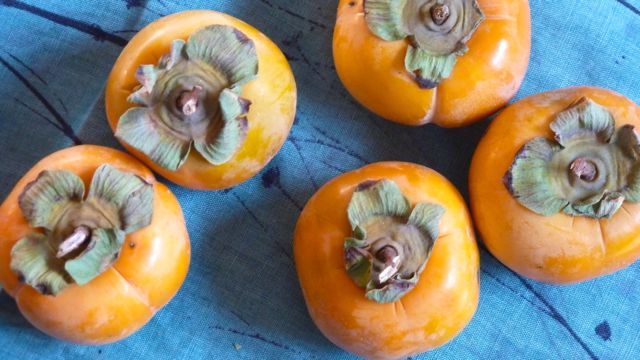They used to be among the best-kept secrets of fall. You had to know someone with a tree. Or know someone who was in on the secret. Now we see them at markets, nestled prominently beside apples and pears—catching our attention with glossy orange skins. Persimmons: they’re the other orange treasures of October.  Still, they remain a mystery to most. Perhaps you recall grandma folding the pulp into moist cakes, but many of us grew up without once encountering a persimmon. We wonder what to do with them, beyond a festive centerpiece. Luckily, there’s loads of options.
Still, they remain a mystery to most. Perhaps you recall grandma folding the pulp into moist cakes, but many of us grew up without once encountering a persimmon. We wonder what to do with them, beyond a festive centerpiece. Luckily, there’s loads of options.
First, a quick primer. You’ll generally see two varieties: Fuyus and Hachiyas. Fuyus are squat rounds (pictured above) that resemble pumpkin-colored tomatoes, while Hachiyas are larger and acorn-shaped. Don’t let their similar appearance fool you. Inside, these beauties are as opposite as stepsisters can be. Most fans prefer to eat Fuyus raw, with their distinctive crunch and mild flavor. They feel much like an apple in hand—and mouth. By contrast, a Hachiya is ready to tackle only as it turns utterly soft—skin taut, poised to burst forth its gelatinous flesh at any second. Bite into a firm one, and you’re in for a nasty mouthful of bitterness. Astringence, to use the technical term.
If you’re blessed with a Hachiya tree, harvest fruit while it’s firm, then allow it to ripen at room temperature. Plucking a fully ripe Hachiya is the orchard-worker’s equivalent of Russian roulette. One tug, and splat—you’re covered in sweet orange goo. In the kitchen (the safest territory to address the ripe fruit), Hachiyas are appreciated for the moist texture they lend to baked goods—we save them for a much-loved spice cake—though some admirers simply scoop the flesh straight from the skin with a spoon. Be sure to position your mouth over an open sink first. Or plan for a change of clothes later.
Not to muddy the waters, but we covet the little Fuyu—it has nearly all of what the Hachiya offers. And more. The Fuyu is a flexible soul. Slice a crisp one, or wait as it ripens to a deep color and oozy softness, just like a Hachiya.  We finely chop firm ones with cilantro and ginger for a vibrant fall salsa (pictured left). Or toss them into a green salad with peppery arugula, tangy pomegranate and toasted pumpkin seeds (second photo from top). Simply peeled, the whole fruit is a healthy treat. Tuck one into the lunchbox of someone you love.
We finely chop firm ones with cilantro and ginger for a vibrant fall salsa (pictured left). Or toss them into a green salad with peppery arugula, tangy pomegranate and toasted pumpkin seeds (second photo from top). Simply peeled, the whole fruit is a healthy treat. Tuck one into the lunchbox of someone you love.
With either variety forgo the skin—the waxy texture makes it tough to chew. If you cut out the stem and leaves, the entire fruit is edible. You might encounter a flat seed on occasion, and if so, just discard it. Or grow a tree. A more beautiful fall sight is difficult to imagine.
Note: click on blue words and phrases in the text above to link to persimmon recipes.
Other ideas for the week:
Apples and celery have enjoyed an inspired, if humble, partnership since the days of creamy Waldorf salad. This rendition is bathed in walnut oil with toasted seeds adding to the crunch.
How about a grown-up peanut butter sandwich—thinly sliced apples and celery layered between slices of toasted bread slathered with peanut butter?
Substitute arugula for lettuce on a sandwich or in a salad. If you find its peppery edge a bit too strong, add some lettuce to mellow out the overall taste.
Sprinkle pomegranate seeds over creamy soups—they lend a hint of sweet-sour flavor plus a pleasant crunch. They also work well with Mexican dishes like mole or enchiladas. Stir them into pilafs and whole-grain salads.



